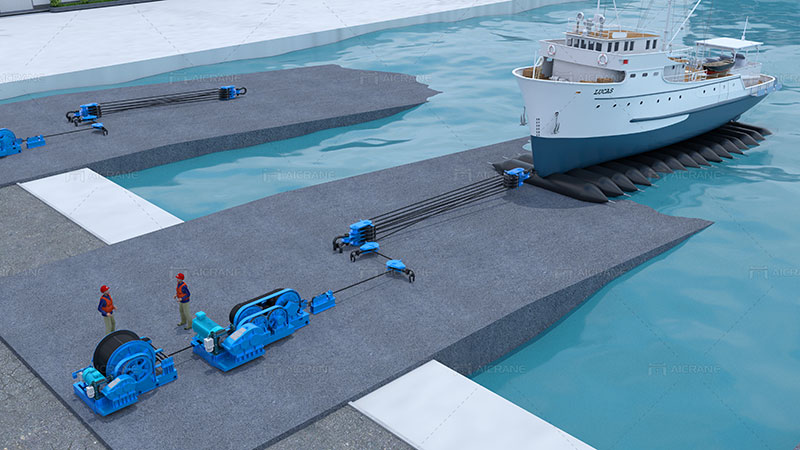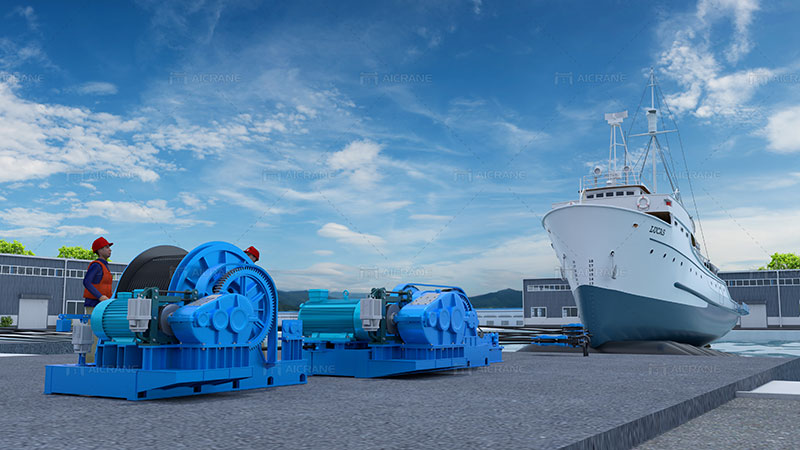Slipway winches play a crucial role in marine operations, particularly in shipyards and slipways, where vessels need to be launched, hauled out, or moved. These winches utilize a working mechanism that involves the use of pulley blocks to pull large vessels. In this article, we will explore the working mechanism of a slipway winch, highlighting the role of pulley blocks and how they enable the smooth and controlled movement of sizable vessels.

Slipway Winch Overview
A slipway winch is a heavy-duty winching system designed to handle the launching and hauling operations of large vessels. Key points about boat slipway winches include:
Robust Structure: Slipway winches are built with sturdy materials to withstand the high pulling forces and harsh marine environments.
Power Source: These winches are typically powered by hydraulic or electric systems, depending on the specific requirements of the application.
Wire Rope: Slipway winches employ strong and durable wire ropes capable of withstanding heavy loads.

Pulley Blocks in Slipway Winches
Pulley blocks, also known as snatch blocks or sheave blocks, are integral components in the working mechanism of slipway winches. Here’s how they contribute to the pulling of large vessels:
Definition and Function: A pulley block consists of one or more grooved wheels, known as sheaves, mounted within a frame. The wire rope passes through the sheave(s), creating a mechanical advantage that increases the winching capacity.
Mechanical Advantage: The primary purpose of pulley blocks is to provide a mechanical advantage by redirecting the force applied to the winch. By utilizing multiple sheaves, the load-bearing capacity of the winch machine is multiplied, allowing for the pulling of larger vessels.
Directional Change: Pulley blocks also enable changes in the direction of the pulling force. They can be positioned to redirect the wire rope, allowing the winch operator to control the movement of the vessel along the slipway.
Working Mechanism
The working mechanism of a slipway winch with pulley blocks involves several steps to ensure safe and controlled vessel movement:
Securing the Vessel: The vessel to be moved is securely positioned on the slipway using appropriate support mechanisms such as cradles or keel blocks.
Attaching the Wire Rope: The wire rope is connected to the vessel using appropriate attachments or slings, ensuring a secure and even distribution of the load.
Deployment of Pulley Blocks: The pulley blocks are strategically positioned along the slipway or fixed structures to create the desired mechanical advantage and change the direction of the pulling force.
Engaging the Winch: The winch operator activates the boat winch, causing the wire rope to be pulled through the pulley blocks. The mechanical advantage provided by the pulley blocks amplifies the pulling force, allowing for controlled and gradual movement of the vessel.
Monitoring and Adjusting: Throughout the pulling process, the winch operator carefully monitors the movement of the vessel and makes necessary adjustments to maintain control and ensure safe positioning.
Slipway winches with pulley blocks provide a robust and effective solution for pulling large vessels during launching, hauling, or repositioning operations. The working mechanism of these winches, utilizing the mechanical advantage and directional control offered by pulley blocks, enables the smooth and controlled movement of sizable vessels along slipways. By understanding the role and function of pulley blocks in slipway winches, operators can ensure the safe and efficient handling of large vessels, facilitating the necessary operations in shipyards and slipways.
